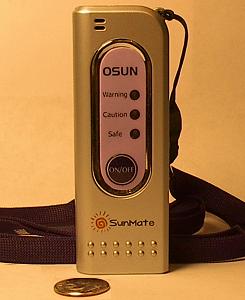
SunMate Personal UV Moniter Introduction About Ultraviolet Solar Radiation About The Ultraviolet (UV) Index
About Osunís SunMate
User Instruction Reducing the risks of overexposure to ultraviolet rays apply sunscreen Size: 1.2"x3.3"x0.5". Weight: 0.7 oz. Made in USA. |
Prevention of skin cancer: Wear protective clothing, including a hat with a four-inch brim. Apply sunscreen all over your body and avoid the midday sun from 10 a.m. to 4 p.m. Regularly use a broad-spectrum sunscreen with an SPF of 15 or higher, even on cloudy days. The following six steps have been recommended by the AAD and the Skin Cancer Foundation to help reduce the risk of sunburn and skin cancer. Minimize exposure to the sun at midday - between the hours of 10 a.m. and 3 p.m. Apply sunscreen, with at least a SPF-15 or higher that protects against both UVA and UVB rays, to all areas of the body that are exposed to the sun. Reapply sunscreen every two hours, even on cloudy days. Reapply after swimming or perspiring. Wear clothing that covers the body and shades the face. Hats should provide shade for both the face and back of the neck. Wearing sunglasses will reduce the amount of rays reaching the eye by filtering as much as 80 percent of the rays, and protecting the lids of our eyes as well as the lens. Avoid exposure to UV radiation from sunlamps or tanning parlors. Protect children. Keep them from excessive sun exposure when the sun is strongest (between 10 a.m. and 3 p.m.), and apply sunscreen liberally and frequently to children 6 months of age and older. Remember, sand and pavement reflect UV rays even under the umbrella. Snow is even a particularly good reflector of UV rays. Reflective surfaces can reflect up to 85 percent of the damaging sun rays. What is skin cancer? There are three main types of skin cancer, including:
Distinguishing benign moles from melanoma: Melanoma Information The number of
new cases of melanoma continues to rise faster than any other type
of human cancer Melanomas vary greatly in appearance. Some melanomas may show all of the ABCD characteristics, while other may only show changes in one or two characteristics. Always consult your physician for a diagnosis |
